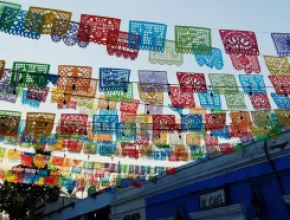For wine and food buffs, not many destinations compare to Napa and Sonoma counties in Northern California, where irresistible sights, scents and tastes greet visitors around every vine-clad corner.
From country farm tours to renowned restaurants, cooking schools, and wine- and food-pairing seminars, there are countless ways planners can spice up agendas in the region and satisfy the gourmand in every group.
Napa County
Napa has enjoyed a prominent place on the international culinary map for years, with star chefs and eateries such as Thomas Keller and The French Laundry, and other established gourmet venues like Tra Vigne and Terra.
“What people have come to expect in Napa Valley is a fantastic food experience,” says Beth Carmichael, executive director of the Napa Valley Conference and Visitors Bureau. “And we’re privileged enough to be considered one of the top culinary and wine tourism destinations in the world. We have The French Laundry, considered one of the best restaurants in the U.S., and some would say in the world.”
Establishments such as The French Laundry, Tra Vigne, Terra, Brix, Martini House, and REDD are well suited to small and midsize gatherings, and while Napa restaurants have perfected the art of group dining, Carmichael says the cuisine scene for groups has significantly expanded over the years.
“Looking back from a group marketing perspective, the culinary experience in Napa has evolved from having a phenomenal restaurant dining experience to today, where people want to continue to be educated throughout their lives, so that aspect has taken off here,” she says. “We have lots of requests from groups for unique culinary ideas.”
Carmichael says two ideal options for educational and participatory food experiences are the Culinary Institute of America (CIA) at Greystone, the California affiliate of the renowned Hyde Park, N.Y.-based CIA, and COPIA: The American Center for Wine, Food and the Arts.
“At the Culinary Institute, groups can do everything from cooking classes to food and wine pairings that explain, for instance, why mustard might not taste good with a chardonnay or why steak goes well with a cabernet sauvignon; it’s all about the science of the food,” Carmichael says.
COPIA opened in 2001 as a cultural center dedicated to the discovery, understanding and celebration of wine, food and the arts.
“We’re class- and program-oriented, but we’re not CIA on any level,” says Diane Hudson, COPIA’s group sales manager. “We’re consumer-driven—an interactive discovery experience.”
Highlights of the facility include workshops, demonstrations, tastings, lectures, films, and art exhibits and performances, and it is home to extensive herb and produce gardens and Julia’s Kitchen, a gourmet restaurant named after Julia Child.
“We do everything from experiential programs to demonstration-style events to group dining,” Hudson says. “Groups can do a cook-your-own, three-course food- and wine-paired dinner for up to 20 people, a hands-on, pizza-making and grilling program for up to 45 people, or a Food Network-style demonstration program in our Meyer Food Forum.”
The forum seats 70 people, and the 75- to 90-minute program features a cooking demonstration, a wine and food pairing and talks by COPIA’s culinary director, wine director and garden director.
“It’s a fun, interactive program that is the quintessential COPIA experience,” Hudson says.
Additionally, Julia’s Kitchen is available for private events, and it also provides the catering for events of up to 400 people at venues throughout COPIA.
Other ways to give groups an educational culinary experience include local cooking schools such as Cooking with Julie, offering team-building-style cooking classes and a farmers’ market tour and class; Cooks and Books and Corks, featuring hands-on cooking classes; and Casa Lana, a bed-and-breakfast in Calistoga that also offers gourmet cooking classes for small groups.
Several properties in Napa Valley are also renowned for their chefs and cooking programs, including Silverado. The resort’s chef, Peter Pahk, has received several People’s Choice and Critic’s Choice awards at the county’s annual Mustard Festival, and he is also known for utilizing sustainable foods and pioneering sustainable practices in the area. Pahk is available to speak on a variety of food-related topics, and groups can take advantage of cooking classes at Silverado, creating dishes such as risotto, sushi and crepes.
Food- and wine-pairing programs are offered at numerous wineries, which can also be rented for unique, culinary-inspired events such as winemaker dinners.
Another hot epicurean adventure in town is the Napa Valley Wine Train, which caters to groups with a number of gourmet dining experiences, all served aboard a restored vintage train that travels throughout the scenic valley.
Meanwhile, planners can treat attendees to Wine Country food gifts through companies such as Made in Napa Valley Jane, which produces more than 65 gourmet products made with all-natural ingredients. Marinades, rubs, pasta sauces, and mustards are among the products available.
The company plans to unveil a new 50,000-square-foot facility in April: the Made in Napa Valley Culinary Artisan Food Experience (C.A.F.E.). The facility will offer a tapas-style tasting bar, a retail shop, and breakfast and lunch, and groups will be able to utilize the venue for special events, cooking classes and behind-the-scenes tours.
Sonoma County
The wine and food experiences to be enjoyed in Sonoma County are just as intense as in Napa, if not even more diverse.
The region, which stretches from the rugged Pacific Coast through the verdant inland valleys and is home to more than 250 wineries, prides itself on its numerous olive oil producers, farmers, fishermen, bakers, and cheese makers. Laura Chenel, one of Sonoma’s food pioneers, introduced America to goat cheese in the late 1970s.
“One of the things that distinguishes us is that in Sonoma, you’re never more than three minutes from a farm; you name it, it’s grown here,” says Ken Fischang, president of the Sonoma County Tourism Bureau, pointing to several unique agricultural experiences for groups. “You can sample and learn how to make goat cheese at Redwood Hill Dairy Farm, pick your own berries and apples, or go mushrooming on an eco adventure in the wilderness. Sonoma produces lamb, ducks, geese, and amazing organic free-range chicken, and it also has the seafood—Dungeness crab and fresh ocean fish.
“There are more than 14 different farmers’ markets throughout the county, where you’ll meet the fish mongers and the cheese makers, you’ll learn how olive oil is produced, and you’ll likely rub elbows with a local chef,” he adds.
Several wineries, hotels and restaurants also have their own gardens, where chefs harvest fresh produce.
“Kendall-Jackson [winery] has a sensory garden and an annual heirloom tomato festival, which this year featured more than 170 different kinds of heirloom tomatoes,” Fischang says. “And if you go to restaurants like Zazu or Madrona Manor [inn and restaurant], the chef is using whatever is right outside the door in the garden.”
With Sonoma’s rich farming heritage, visiting groups are increasingly learning to appreciate the art of terroir, the concept of eating food and drinking wine that comes from the same soil, according to Fischang.
“Sonoma has 14 different American Viticultural Areas (AVAs), and there are so many factors that come into play that give the wine and food complementing flavors,” he says. “Some wines are grown near or around olive groves, so it may have a green pepper or olive flavor, so what better wine to enjoy when doing olive oil tastings, which abound here?” he says.
Fischang adds that an excellent way for groups to get a true taste of Sonoma is through food- and wine-pairing programs at wineries such as J, Kendall-Jackson and St. Francis, all of which have their own chefs and offer event space.
B.R. Cohn Winery is becoming well known for its olive oils, and it features a new gourmet food shop where groups can taste olive oil and vinegar, among other products.
Meanwhile, one of Sonoma’s biggest culinary claims to fame is chef John Ash.
“John Ash is really the person who created Wine Country cuisine—cooking with fresh local foods and produce and pairing it with regional wine,” says Ginger Guthrie, president of Napa-based DMC Destination Design Group and its newly created division, Taste, which utilizes Ash and other celebrity guest chefs for group cooking classes and speaking engagements in Sonoma and Napa. “A lot of our clients are very savvy, and they all want a food and wine element now.”
Ash’s restaurant, John Ash & Co. at the Vintners Inn, is a top group dining option and one of Sonoma’s best choices for group cooking classes, along with other venues like Relish Culinary School.
“John Ash & Co. is also one of two places where groups can dine literally sitting in a vineyard, in this case, next to 92 acres of the Vintners Inn,” Fischang says. “The other option is at Francis Ford Coppola’s Winery, Rosso y Bianco, which has a cafe sitting in the middle of a vineyard.”
Aside from John Ash & Co., premier Sonoma County restaurant choices for groups include Cyrus, Zazu, River’s End, Madrona Manor, Farmhouse, and The Fig Cafe, which is owned by The Girl and the Fig, a top Sonoma caterer that also produces gourmet artisan food products.
Before any attendee leaves town, they usually find themselves savoring the ambience of a specialty grocery store, such as Pacific Market or Oakville Grocery, which prominently feature the fresh foods of the region.
“When visitors come here, it’s hard to get them out of the grocery store,” Fischang says. “The markets are phenomenal culinary excursions in themselves."
For More Info
Calistoga COC 707.942.6333
www.calistogafun.com
Napa Valley Conference and Visitors Bureau 707.226.7459
www.napavalley.org
Santa Rosa CVB 707.577.8674
www.visitsantarosa.com
Sonoma County Tourism Bureau 707.522.5800
www.sonomacounty.com
Sonoma Valley Visitors Bureau 707.996.1090
www.sonomavalley.com







